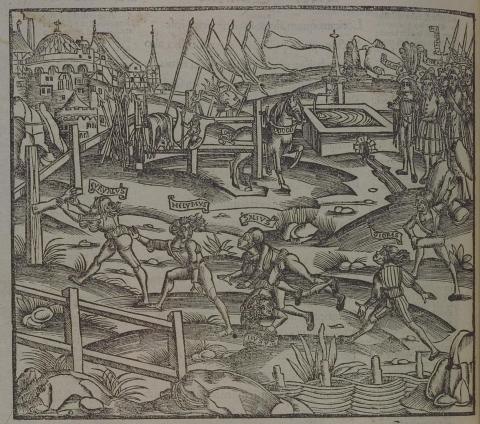Annotations
In the upper right corner, Achates, Aeneas, Acestes and another labelled person, likely Ascanius, stand with their followers next to a large fountain watching a foot race. To the left of the fountain, prizes have been laid out for the contestants; there is a horse with full trappings for the winner, a set of Thracian arrows for the second place, and an Argive helmet for the third place (303-14). A lion skin, awarded to Salius (351-2), and a shield, awarded to Nisus (353-61), are displayed among the prizes. Virgil has the race take place in a valley, the shape of a theatre (286-9), but Brant has it take place in a fenced-off portion of a field very close to a building that might be the palace of Acestes. The contestants, in the lower half of the image, run toward a marker on the fence, which, inexplicably, is shown here as a human arm nailed to a post. Euryalus, in the lead, touches the marker first. Close behind him is Helymus. Salius would be third, but Nisus [Nysus], who has fallen on the ground, reaches out his leg to trip Salius. He does this to help Euryalus, his lover, gain first place. Diores, shown in last place here, will soon pass the fallen runners to take third. (318-39) (Katy Purington)
Woodcut illustration from the “Strasbourg Vergil,” edited by Sebastian Brant: Publii Virgilii Maronis Opera cum quinque vulgatis commentariis expolitissimisque figuris atque imaginibus nuper per Sebastianum Brant superadditis (Strasbourg: Johannis Grieninger, 1502), fol. 238v, executed by an anonymous engraver under the direction of Brant.


Sebastian Brant (1458-1521) was a humanist scholar of many competencies. Trained in classics and law at the University of Basel, Brant later lectured in jurisprudence there and practiced law in his native city of Strasbourg. While his satirical poem Das Narrenschiff won him considerable standing as a writer, his role in the transmission of Virgil to the Renaissance was at least as important. In 1502 he and Strasbourg printer Johannes Grüninger produced a major edition of Virgil’s works, along with Donatus’ Life and the commentaries of Servius, Landino, and Calderini, with more than two hundred woodcut illustrations. (Annabel Patterson)